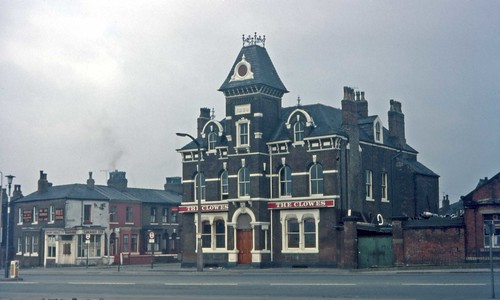Black Lion, Chapel Street, Salford. (c) tysonsbeerblog.
The Black Lion on the corner of Blackfriars Road and Chapel Street has reopened as a community hub offering café and internet facilities during the day as well as continuing as a fine pub, as reported by
Man Con [1] and then later in the
Evening News [2]. Read much more here at the independent
Salford Star magazine [3]. Interestingly, new landlords, Jenny Archibald and Mark Ashmore of
FutureArtists, are film-makers and they plan to stream films in a cinema upstairs. We wish them well with this venture, but during our Saturday evening visit, we were most interested in the pub and beer.
Thankfully, we weren't let down as both were on terrific form. A modest £4,000 has been spent on the refurb, but it's only been closed 18 months or so, and little has changed from the old pub. Downstairs is smaller than you might expect but old-fashioned furniture and a low-key music give it a pleasant atmosphere. Impressively, they already had real ale on (unlike its neighbour, the Rovers Return), with an endearingly handwritten pump offering Copper Dragon (best bitter?) which was as good as ever. The Black Lion was nice and busy and the old locals we chatted to were pleased to share memories of the old pub and many, many more. A welcome return for the Black Lion, and one we hope heads the rebirth of Chapel Street.
ORIGINAL ENTRY:
Recently closed after a short-lived renaissance, the Black Lion is a large distinctive pub on the corner of Blackfriars Street and Chapel Street. The chap who runs the hugely successful
New Oxford up the road on Bexley Square, Tim Flynn, tried to make a go of this former keg-only pub in 2009. However, a combination of real but rather uninspiring ale, a refusal to use sparklers and the pub company, Enterprise, hiking up rents, led to the Black Lion closing in July 2010 and it remains boarded up today [4]. In 1975 its architecture was described as "majestic late-Victorian" with large rooms, each with their own bar, and an upstairs function room. On offer was Brew 10 and mild, Carling, Worthington E and Guinness [5].
The Black Lion can be traced back to 1776 when it was first licensed to John Kinnaston although it was sometimes listed as the White Lion and the Golden Lion. By 1876 the tumbledown pub was replaced by the grand building we see today, possibly with the help of
Hardy's Brewery of Hulme. They took the Black Lion over a few years later and 1906 John Marsh advertised it as a family and commercial hotel , one minute from the Exchange and Victoria Stations. Bass took over the pub in the 1960s before the Pub Co's Centric and finally Enterprise owned it [6]. With no likelihood of the it reopening any time soon, maybe the proposed
Chapel Street regeneration scheme will eventually breathe life back into this grand old boozer.


































